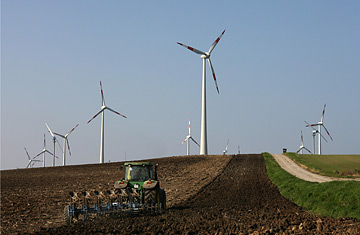
Wind turbines in Dardesheim, eastern Germany.
(2 of 2)
If the U.S. were to introduce similar laws, environmentalists say, it could expect even bigger gains. Across Germany, it's common to see houses with solar-photovoltaic panels on their south-facing roofs. But Germany is cold and without bright sunshine for much of the year. "The use of photovoltaic technology in sunny states like California or Arizona is definitely going to be much more successful than in our own country," says Reinhard Bütikofer, chairman of the Greens political party. The U.S. could also use other technologies unsuitable for the German climate, like solar-thermal power plants. Germans are now building giant offshore wind farms in the North Sea; windmills are hundreds of meters tall, with blades the length of football fields. But the U.S. has space to build large wind farms on land, where they are much cheaper to construct and maintain.
How much difference do renewables really make to global climate change? Wind power, the logic goes, only works when the wind is blowing. But here, too, the German example may prove instructive. Take Schmack Biogas. Since it's cheap to store gas (and not cheap to store electricity) Schmack has collaborated with solar and wind producers to develop what they call "an integrated energy system." If the sun is too dim to match demand, supply is topped up by burning stored biogas.
Germany's emphasis on renewables has done more than help meet its climate-change goals. It has been an economic success, too. There are now nearly 250,000 Germans employed in the renewable-energy sector, and renewable-energy exports have boomed. "We are going to prove that climate-change [action] and economic prosperity are not contradictions, but are mutually dependent," says Environment Minister Sigmar Gabriel. That message seems to be catching; Spain, Italy — and the state of California — now have their own versions of the feed-in law.
Generation Green
How did Germany come to be a pacesetter in environmental politics? Germany's modern environmental movement began in much the same way as the U.S. movement did — as an element of the countercultural fringe in the late 1960s and 1970s. But whereas most U.S. environmentalists stayed within traditional political parties — or devoted their energies to pressure-group activity — German activists took a different route. In 1979 in Bremen, a Green party won seats in a state parliament for the first time. The federal Green party was officially founded the following year, and under early charismatic leaders like Petra Kelly, who was murdered in 1992, quickly became a force to be reckoned with. Initially, the party was divided between "fundis," who saw political compromises as a betrayal of their ideals, and "realos," who saw, correctly, that Germany's laws offered minority parties a leg up — at least compared with those in other countries. Germany grants seats in the Bundestag to any party that wins more than 5% of the popular vote, which meant that, by 1983, the Greens were represented there. By 1998, when they won just under 7% of the national vote, the Greens were sufficiently trusted to enter a coalition with the Social Democratic Party; Green leader Joschka Fischer, a militant left-wing activist in the 1970s, became Foreign Minister.
By now, environmentalism is deeply embedded throughout German politics. Chancellor Angela Merkel is a conservative, but has become a world leader in promoting policies on climate change. As in the U.S., the natural landscape — the woods and the water — has long been a defining element of national character. But although environmental issues came to the fore in many nations in the 1980s, some specifically German concerns helped. As acid rain stripped German forests in the 1980s, Bavaria's conservative élites grew worried about the health of their land.
Perhaps the most galvanizing issue was nuclear power. On the front lines of the cold war, Germans were always acutely aware of the possible dangers of nuclear energy. After the 1986 accident at Chernobyl in Ukraine — from which a radioactive plume wafted over much of central and Eastern Europe — it was a conservative Chancellor, Helmut Kohl, who created a federal ministry to oversee nuclear safety and the environment. Kohl's government, too, introduced Germany's first feed-in law in 1991. As German industries discovered that they could thrive despite tough environmental regulations — and indeed develop export markets for green technologies — so a broad consensus on the benefits of going green spread. "It wasn't inherently German. Environmental conservation became a more ingrained part of German culture," says Miranda Schreurs, director of the Environmental Policy Research Center at the Free University of Berlin. In Germany today, she says, "People turn off the lights. People are much more conscious of what they throw away and where they throw it away."
The impact of a similar shift in attitudes could be even more striking in the U.S. "We are more risk-averse," Helmut Weidner, an environmental-policy expert at Social Science Research Center Berlin, says of his fellow Germans. U.S venture capitalists are already betting on green tech. "If the next national government in the U.S. puts more emphasis on climate and energy policy, and there are new laws and so on, I think then Germany will very quickly go back to a second or third ranking." As part of that new plan, U.S. lawmakers might adopt some of their German colleagues' ways. Last year Democrats proposed making the House carbon-neutral, by purchasing offsets and switching from coal to lower-emission natural gas at the plant that heats the Capitol. It's a start, though a more sweeping 2007 bill to address government's carbon footprint has yet to get a vote. What's needed in Washington? A bit of that old can-do German spirit.